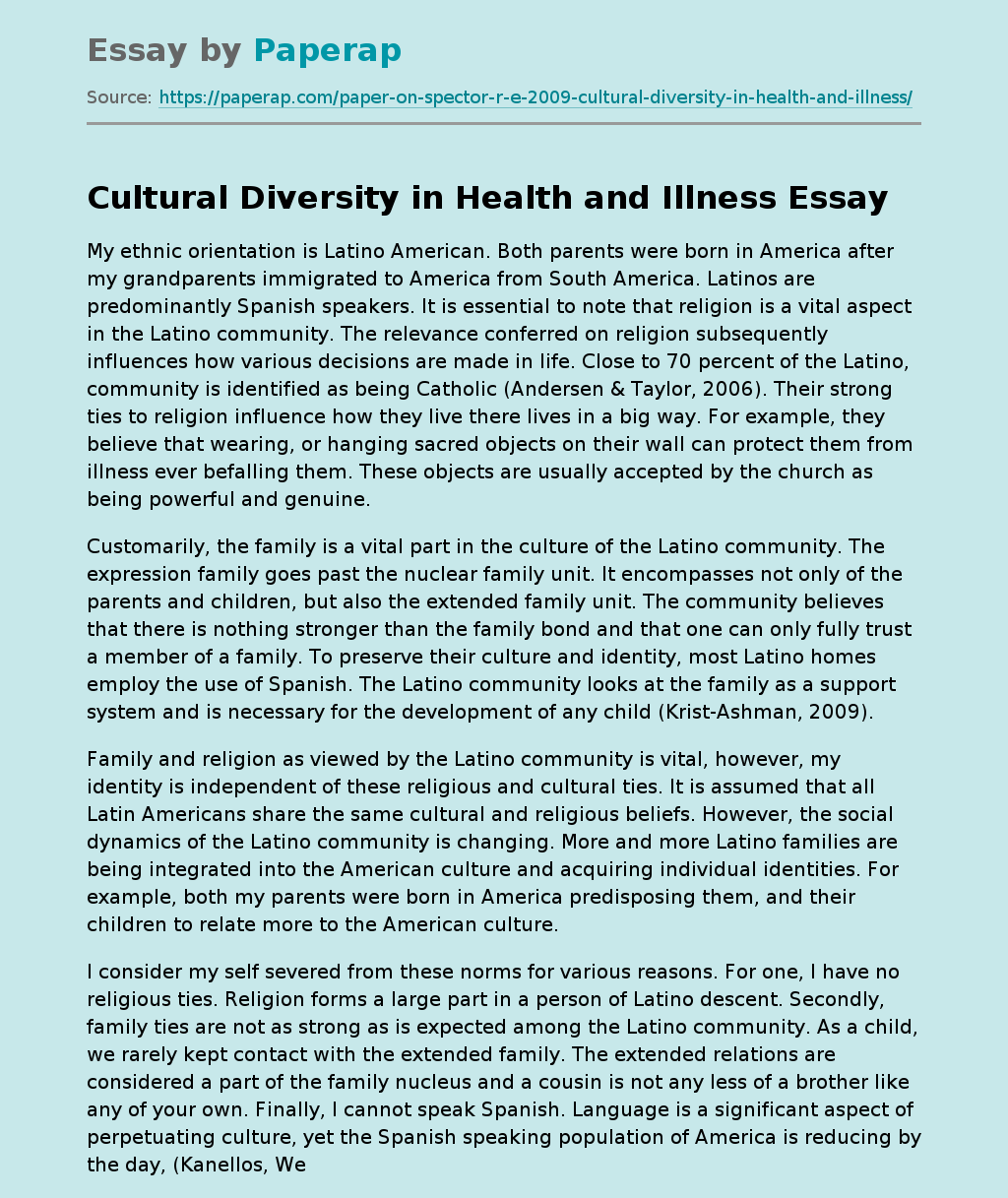My ethnic orientation is Latino American. Both parents were born in America after my grandparents immigrated to America from South America. Latinos are predominantly Spanish speakers. It is essential to note that religion is a vital aspect in the Latino community. The relevance conferred on religion subsequently influences how various decisions are made in life. Close to 70 percent of the Latino, community is identified as being Catholic (Andersen & Taylor, 2006). Their strong ties to religion influence how they live there lives in a big way.
For example, they believe that wearing, or hanging sacred objects on their wall can protect them from illness ever befalling them. These objects are usually accepted by the church as being powerful and genuine.
Customarily, the family is a vital part in the culture of the Latino community. The expression family goes past the nuclear family unit. It encompasses not only of the parents and children, but also the extended family unit. The community believes that there is nothing stronger than the family bond and that one can only fully trust a member of a family.
To preserve their culture and identity, most Latino homes employ the use of Spanish. The Latino community looks at the family as a support system and is necessary for the development of any child (Krist-Ashman, 2009).
Family and religion as viewed by the Latino community is vital, however, my identity is independent of these religious and cultural ties. It is assumed that all Latin Americans share the same cultural and religious beliefs.
However, the social dynamics of the Latino community is changing. More and more Latino families are being integrated into the American culture and acquiring individual identities. For example, both my parents were born in America predisposing them, and their children to relate more to the American culture.
I consider my self severed from these norms for various reasons. For one, I have no religious ties. Religion forms a large part in a person of Latino descent. Secondly, family ties are not as strong as is expected among the Latino community. As a child, we rarely kept contact with the extended family. The extended relations are considered a part of the family nucleus and a cousin is not any less of a brother like any of your own. Finally, I cannot speak Spanish. Language is a significant aspect of perpetuating culture, yet the Spanish speaking population of America is reducing by the day, (Kanellos, Weaver & Fabregat, 1994).
The information regarding a person’s ethnic background is crucial in Health care. This information will give medical practitioner a better chance helping the patient achieve positive results. Religion affects how one looks at signs and symptom of a disease (Spector, 2009). It is believed by most that sickness is not just about the physical condition of a patient, but also the mental and spiritual disposition. In this case, curing illnesses requires a spiritual and mental approach as much as it needs physical intervention. Some people look at a sick person and believe that someone may have cast an evil eye on them because of jealousy or some other reason. Others believe that man has supernatural ability to cause sickness. This can be attributed to witchcraft or and voodoo. Different cultures have different ways of tackling these situations, and it is incumbent on the medical practitioner to harmonize modern medicine and traditional beliefs about health an illness.
A family member may request a priest to pray for the patient to cast away the evil eye. As a medical practitioner, one should understand that the religious needs of a patient to ensure the family and patient are at peace. Healthcare that respects the diverse cultural belief systems about health nurtures positive health results (Yabro, Wujcik & Gobel, 2007). The understanding of a people’s culture goes a long way in solving problems in health care and other professions, as well.
References
Andersen, M. L., & Taylor, H. F. (2006). Sociology: Understanding a diverse society. Belmont, CA: Thomson/Wadsworth.
Kirst-Ashman, K. K. (2007). Introduction to social work and social welfare: Critical thinking perspectives. Belmont, CA: Thomson Brooks/Cole.
Spector, R. E. (2009). Cultural diversity in health & illness. Upper Saddle River, N.J: Pearson Prentice Hall.
Weaver, T., Kanellos, N., & Esteva, F. C. (1994). Handbook of Hispanic cultures in the United States: Anthropology. Houston, TX: Arte Pu?blico Press.
Yabro, C.H., Wujcik, D., Gobel, G.H. (2010). Cancer Nursing: Principles and Practice. Burlington, MA. Jones & Bartlett Publishers.
Cultural Diversity in Health and Illness. (2019, Feb 06). Retrieved from https://paperap.com/paper-on-spector-r-e-2009-cultural-diversity-in-health-and-illness/

